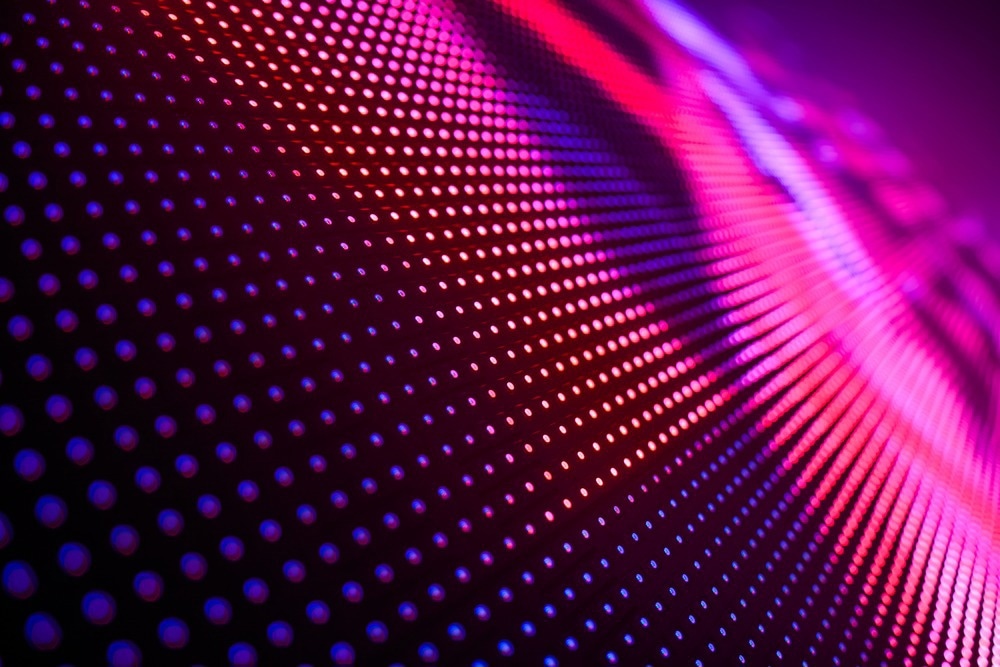Pre-proof research in Nano Energy explores the hole interlayer-dependent interfacial energetics of light-emitting diodes by combining imaging contact polarization/potential difference and multi-time scale voltage/capacitance response. This opens up new possibilities for next-generation high-efficiency displays and optical data communication.

Study: Unraveling Hole Interlayer-Dependent Interfacial Energetics of LEDs. Image Credit: Ash Pollard/Shutterstock.com
When electrodes directly touch light-emitting Poly-TPD with strong-weak polarization, alternate dominance of capacitance and resistance characteristics emerge. This causes the current stagnation in LEDs with higher voltages.
Including hole-interlayer results in a more disordered polarization direction and a higher intensity, producing many carrier hopping channels and a high electrical field.
LEDs in Data Communication
Optical communication is a modern alternative for transferring digital data via electric voltage signals. An essential component of any optical data transfer system is light-emitting diodes (LEDs). LEDs transform the electrical signal into a corresponding light signal to be injected into the fiber.
LEDs are frequently the most expensive component in the system, and their properties can substantially impact the final performance limits of a given system.
Significance of Hole Transporting Layer in LEDs
Understanding and exploiting the underlying interfacial physics is crucial for engineering breakthroughs in a system-level collaborative device such as LEDs.
High-performance LEDs require hole transporting layers (HTLs), which primarily implement hole injection and transport. Hole transport requires more intricate modeling than its electron counterpart.
When connecting organic hole transporting layers with high ionization energy, common electrodes for LEDs, including indium-tin-oxide (ITO), result in significant injection barriers.
The buffer layers achieve the uncontrolled flow of charge between the emitter and injector. Using multi-hole transporting layers with stepped and gradient electronic profiles improves the limited electronic interface between emitter and injector.
PEDOT:PSS/Poly-bilayer TPD's architecture is used, and occasionally they are the only hole transporting layers between the electrodes and the emitters.
The electroluminescence (EL) will not occur until the end of the current stagnation and the beginning of the second growth, which raises energy consumption.
The heterogeneous properties of the interfacial charges that result from this will substantially impact the strength and distribution of the local electric field, causing irreparable harm to the breakdown and operating dependability of LEDs.
Investigating the LEDs' Hole Interlayer-Dependent Interfacial Energetics
Researchers within the Nano Energy study have combined Kelvin probe force microscopy (KPFM) with imaging contact potential/polarization difference and impedance spectroscopy with multi-time scale capacitance/voltage response to examine the hole interlayer-dependent carrier energetics and dynamics of LEDs.
Kelvin probe force microscopy (KPFM) helped investigate interfacial band alignment by detecting the contact potential difference (CPD) between tips and samples.
The size of the difference in polarization between PEDOT:PSS and Poly-TPD was studied using the amplitude channel in KPFM.
The resulting energetics in OLED were further examined after analyzing the interfacial physics of hole-dependent devices.
Mott-inverse Schottky's capacitance squared against voltage method was used to investigate the electric field distribution.
Instead of only modifying hole transporting layers to meet the gradient energy level criterion, a more thorough interfacial analysis was conducted.
A Keithley 2400 source meter, a spectrometer, and an integration sphere were used to measure the current density-voltage-luminance properties and electroluminescence spectrum of LEDs.
A MultiMode8 atomic force microscope helped measure the height distribution, surface potential, phase, and amplitude while using conductive tips coated in PtIr following the frequency-modulation (FM) KPFM model.
The Fs-Pro semiconductor parameter testing system was used to test the current high-speed responsiveness.
Important Findings of the Study
The poly-TPD blue-emitting buffer layer had regular namatic stripes with alternately strong and weak polarizations.
This orderly alternating polarization pattern is primarily responsible for the alternating dominance of capacitance/resistance when poly-TPD directly contacts ITO, causing a current stagnation density for LEDs.
The current density-voltage (J-V) curve of perovskite LEDs (PeLEDs) shows a standstill and two sizable jumps when the hole interlayer is removed.
Inserting a hole interlayer (PEDOT:PSS) results in a more disordered polarization direction and an increase in polarization intensity, leading to the formation of many carrier hopping channels and an improved electrical field.
Dynamic and rapid charge transfer between ITO electrode and Poly-TPD ensures the J-V of LEDs with conventional diode exponential variation, resulting in resistive proportion at low voltages, capacitive reactance behaviors, and inductive reactance at high voltages.
The different response of hole interlayer-dependent devices to frequencies was clarified, offering new insights into the interfacial physics of LEDs for the next generation of high-efficiency displays and high-speed data transmission.
Reference
Cheng Yan, Xiankan Zeng, Qungui Wang, Xiaodong Peng, Wen Li, Jingjing Cao, Yue Gao, Xiang Chu, Xuehai Fu, Shiyu Yang, Yongjian Chen and Weiqing Yang. (2022) Unraveling Hole Interlayer-Dependent Interfacial Energetics of LEDs. Nano Energy. https://www.sciencedirect.com/science/article/pii/S2211285522006991
Disclaimer: The views expressed here are those of the author expressed in their private capacity and do not necessarily represent the views of AZoM.com Limited T/A AZoNetwork the owner and operator of this website. This disclaimer forms part of the Terms and conditions of use of this website.